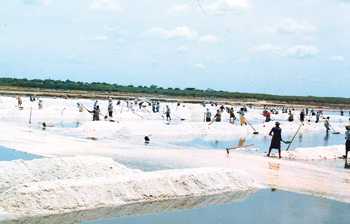The 1956 Bandaranaike
government adopted a Nationalisation Policy and most of the public
utility systems and
essential industries were nationalised bringing them under government control.
The State Industrial Corporation Act No.49 of 1957 was enacted, under which several Public Corporations were
established. Among them was the National Salt Corporation which was set up on December 3, 1957. The Corporation which functioned under the Ministry of Industries thereafter took over the salt industry in Sri Lanka. The salterns where the salt is produced belonged to the State.
With a change in policy from nationalization to
privatization after 1977, most corporations were done away with and the businesses were handed over to the private sector. Lanka Salt Ltd., incorporated in 1990, manages the three salterns in the South – Hambantota, Bundala and Palatupana. Mantai Salt Ltd., was formed in August 2001 to take over the salterns in Mannar and Chemmani in Jaffna.
 |
| A saltern |
Production in the
northern salterns has been adversely affected due to civil disturbances while the tsunami in December 2004 disrupted the production of salt in the south. Weather plays a key role in salt
production. Heavy
rainfall affects production since sunshine is needed to manufacture salt.
Salt is one of the most common items used in the household. The most
popular food spice, salt is a dietary mineral composed primarily of sodium
chloride that is essential for animal life. Salt flavour is one of the basic tastes.
It is also an important
preservative.
As a universal commodity, it plays an important role today in human survival and well being. Medical
science utilizes salt as the universal carrier for iodine in the eradication of
preventable brain damage and iodine deficiency
disorders. Salt is involved in regulating the water
content (fluid balance) of the body. Over-consumption of salt, however, increases the risk of health problems, including high blood pressure.
The manufacture of salt has been a simple operation from the days of the ancient kings.
Driving past Hambantota, it was a common sight, not many years ago, to see large tracts of white 'sheets' on the left hand side of the road. During the high tide the lagoon gets filled with sea water which does not flow back due to the high temperature and wind.
The result is the formation of salt. As in paddy
cultivation, harvesting of salt is also done in two
seasons. The Maha season stretches from July to October and the Yala
season from February to mid-April.
The method of salt
production has undergone changes over the years. Due to increased demand, the natural flow of water from the sea was found to be insufficient. Sea water had to be pumped through channels to the lagoon in order to obtain additional water. The saturated sea water is pumped into
specially prepared areas known as salt pans where it is kept until crystalisation, after which the water is diverted to the specially prepared salterns. Due to further evaporation, salt is formed after which it is
collected and transported for storage.
Common or edible salt is washed, dried and sprayed with an iodine solution before packing. Table salt is prepared according to a special formula.
Earlier, raw salt was made available for sale in boutiques in gunny bags. In the household, pieces of salt were put into a coconut shell and water added for use in curries. The 'lunu polkatta' thus became a key element in the kitchen. Children loved eating raw 'veralu' with a piece of salt. Today, salt comes in
attractive packs branded under different names and it is a 'pinch of salt' that is used.
The manufacture of salt has been modernized and the first ever salt refinery has been opened in Puttalam by Raigam Wayamba Saltern (Pvt) Ltd.
Production of salt to meet the local demand has become a problem and there is talk about the need to import salt. Meanwhile, Lanka Salt has launched an eco-friendly
development programme.
A modern factory has been built for the iodization of the entirety of salt
produced by Lanka Salt Ltd., to the highest health standards at a capacity of no less than 15 tons per hour. Production
commenced in April 2007.
|


